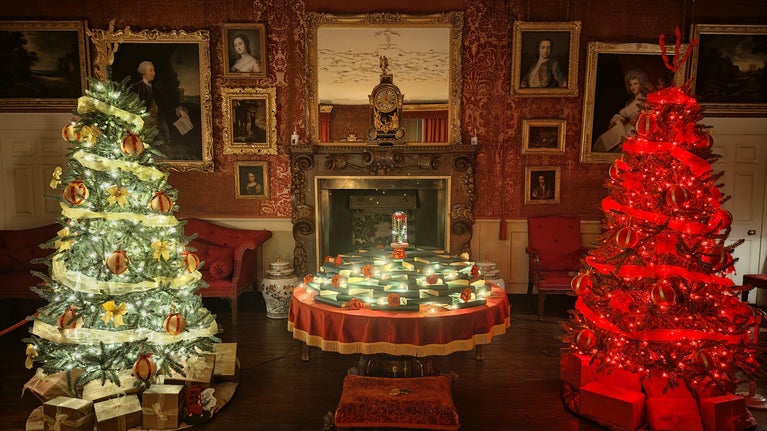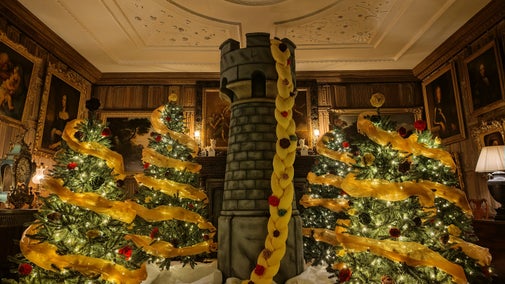
Discover more at The Vyne
Find out when The Vyne is open, how to get here, the things to see and do and more.

From 22 November to 5 January 11am-3pm, immerse yourselves in the magic of best-loved fairy tales. Explore the ground floor of the house aglow with sparkling Christmas trees and atmospheric lighting. There are eight stories to discover. Free with usual admission (closed 24 & 25 December). Collect timed tickets for house on arrival - no pre-booking.
The Sandys and Chute families made The Vyne their home for over 500 years. They accumulated beautiful and important objects and made significant changes to the house during their lives. Come back after Christmas to enjoy the collection in opulent state rooms and humble servants’ quarters.Sat 22 Nov - Tue 23 Dec and then Fri 26 Dec - Mon 5 Jan: Ground floor open daily decorated for Christmas 11am-3pm. 𝐓𝐡𝐞 𝐕𝐲𝐧𝐞 𝐢𝐬 𝐜𝐥𝐨𝐬𝐞𝐝 𝟐𝟒 & 𝟐𝟓 𝐃𝐞𝐜𝐞𝐦𝐛𝐞𝐫 𝟐𝟎𝟐𝟓. Tues 6 Jan - Sun 1 Mar: Ground floor open weekends only 11am-3pm. 𝐒𝐮𝐛𝐣𝐞𝐜𝐭 𝐭𝐨 𝐯𝐨𝐥𝐮𝐧𝐭𝐞𝐞𝐫 𝐚𝐯𝐚𝐢𝐥𝐚𝐛𝐢𝐥𝐢𝐭𝐲.
Explore ground floor rooms illuminated by twinkling trees and atmospheric lighting.
After 5 January, enter the house through the door on the South Drive and discover intriguing stories about The Vyne's former residents. With Grecian pillars, sweeping balconies and plasterwork like royal icing, the 18th-century staircase hall is a sight to behold.
Tucked away in a ground-floor ante-room, examine the intricate detail on Lattimo plates handpainted with 18th-century Venetian scenes. In the stone gallery, you’ll find a Tudor roundel that emulates the style and grandeur of the ancient world. The Vyne's pre-Reformation chapel showcases the earliest depiction of Henry VIII in stained glass.
Whether you want to see the house’s surviving examples of Tudor craftsmanship or admire the exquisite taste of John Chute, here are key things to look out for after Christmas.

Find out when The Vyne is open, how to get here, the things to see and do and more.
Available to book for weekdays Mon 24 Nov – Wed 17 Dec 12pm-2pm in the Brewhouse tea-room. 2 courses, hot drink and mince pie £25 per person. 3 courses, hot drink and mince pie £30 per person. Click through to see menu and book. Normal admission applies.

Open 22 Nov 2025 - 5 Jan 2026 inclusive (Closed 24 & 25 Dec) re-live the magic of best-loved fairy tales. On the ground floor of the house discover The Snow Queen’s icy realm, Red Riding Hood’s cunning wolf and Beauty and the Beast's elegant tea set. A free family trail runs through the house and gardens. House ground floor open 11am-3pm, gardens 10am-4pm. 𝐂𝐨𝐥𝐥𝐞𝐜𝐭 𝐲𝐨𝐮𝐫 𝐡𝐨𝐮𝐬𝐞 𝐭𝐢𝐦𝐞𝐝 𝐭𝐢𝐜𝐤𝐞𝐭𝐬 𝐨𝐧 𝐚𝐫𝐫𝐢𝐯𝐚𝐥 𝐚𝐭 𝐕𝐢𝐬𝐢𝐭𝐨𝐫 𝐑𝐞𝐜𝐞𝐩𝐭𝐢𝐨𝐧. 𝐍𝐨 𝐩𝐫𝐞-𝐛𝐨𝐨𝐤𝐢𝐧𝐠, 𝐟𝐢𝐫𝐬𝐭-𝐜𝐨𝐦𝐞-𝐟𝐢𝐫𝐬𝐭-𝐬𝐞𝐫𝐯𝐞. New for 2025, book your Christmas lunch in the Brewhouse tea-room available on weekdays 24 Nov - 17 Dec at 12pm. Click through for the Christmas Lunch Menu and to book your Christmas Lunch.

Discover centuries of history at The Vyne. Explore the people who shaped the estate, its royal connections to Tudor monarchs and its wartime role.
